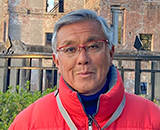
Award summary
Today, as usual, Mr. Kosei Mito (age 78) stands at the foot of the Atomic Bomb Dome that conveys the disastrousness of the atomic bomb that was dropped on Hiroshima City on August 6, 1945. He comes to the Atomic Bomb Dome and stands in front of it from ten o'clock in the morning to around five o'clock in the afternoon almost every day except for rainy days. It takes him about 40 minutes for to bike to the Atomic Bomb Dome from his home. He has used his fluent English to volunteer to share the reality of the atomic bombing with visitors from Japan and abroad. To date, he has guided over 300,000 people, including about 95,000 visitors from 180 countries.
He is an in-utero hibakusha, a survivor of the atomic bombing who was in his mother's womb at the time. His parents never talked about their experience of being bombed. He realized that he was an in-utero hibakusha when his mother gave him his Atomic Bomb Survivor Certificate when he was 20 years old.
After graduating college, he worked as an English teacher at the prefectural high school. The year he turned 50 was a turning point for him. He met Ms. Suzuko Numata, who continued her work telling the story of her experience being bombed while using a wheelchair when he participated in a monument tour in the Peace Memorial Park as part of a training program. Ms. Numata died at the age of 87 in 2011. Listening to her, he was shocked to realize how ignorant he was even though his family, including himself, were atomic bombing survivors. He retired early from his teaching job at the age of 58 and started to learn about atomic bombing. He thought that young hibakusha like him should take over her role. He worked as a guide for the museum. However, he was only allowed to work once a week, working shifts. To be a guide everyday, he started to volunteer as a guide in front of the Dome in the summer of 2006, when he turned 60. Since then, he has been a volunteer guide for over 17 years.
The purpose of being a guide is to "spread seeds of peace." This phrase can be found in Ms. Numata's notes. It means to communicate the reality of the atomic bombing to as many people around the world as possible to eliminate nuclear weapons. To do this, he tries to convey facts accurately, clearly and in a way that touches people's hearts.
When talking to people as a guide, Mr. Mito shows them his Atomic Bomb Survivor's Certificate first and talks about his family. Using a book he made himself about atomic bombs and nuclear weapons that includes photos, illustrations, charts and tables, he conveys basic knowledge about Hiroshima by explaining why the atomic bomb was dropped on Hiroshima, how it was dropped, where it exploded, what happened after the explosion, when the radiation subsided and the secret to the prompt restoration of infrastructure. If visitors have time, he guides them to other places such as the place of the bombed jizo (stone statues), the cemetery and the hypocenter. His book has been prepared in eight different languages with the help of volunteers from abroad who offered to translate it into their own languages. Many visitors are absorbed by the file book, taking an hour or two to look at it. Many different people visit the Atomic Bomb Dome, including tourists, foreign students, adults and children. People traveling all the way from their countries have a much higher level of interest than Japanese people. The most frequently asked question is how long the residual radiation remained. Some foreign visitors ask incisive questions and Mr. Mito says that, "You cannot answer such questions with half knowledge." To answer all possible questions, he has read hundreds of books on atomic bombs and continuously gathers new information.
He receives thank-you emails from all over the world. Now you know the facts. How do you feel? What will you do? This varies according to the individual. He hopes to continue to conveying the facts at this place as long as he is able.
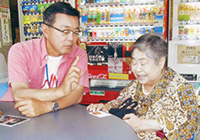 Meeting Ms. Numata, he was shocked to find out that there was so much he didn't know about, despite being another bombing victim.
Meeting Ms. Numata, he was shocked to find out that there was so much he didn't know about, despite being another bombing victim.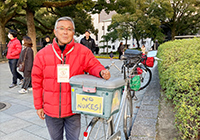 Every morning, he rides his bicycle about 40 minutes to the Atomic Bomb Dome and guides many visitors from within Japan and overseas.
Every morning, he rides his bicycle about 40 minutes to the Atomic Bomb Dome and guides many visitors from within Japan and overseas.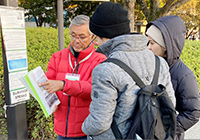 In guiding tourists, he places importance on accurately communicating facts in an easy-to-understand manner.
In guiding tourists, he places importance on accurately communicating facts in an easy-to-understand manner.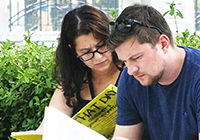 Currently he has files written in eight different languages with the help of foreign people who offered to translate it into their own languages.
Currently he has files written in eight different languages with the help of foreign people who offered to translate it into their own languages.Reasons for this award
We were impressed by his efforts to convey facts clearly to many people by making his guide book in eight languages and his human strength found in his attitude of speaking carefully as if sowing seeds of peace as an in-utero hibakusha, in addition to his track record of guiding a total of over 300,000 visitors. As conflict is unending around the world, as seen in the conflicts in Ukraine and Middle East, we believe atomic bombing storytellers including Mr. Mito who hope for peace and the activities they engage in are more important than ever.
Comments from the winner
I was surprised to suddenly hear about the award. I was moved by the goal of the award: to celebrate people who impress other citizens. I feel my activities as a guide receive enough acclaim just by seeing the reactions of the visitors I guide and receiving their thank-you emails. I never thought I would received recognition like this. My family, fellow guides, and the people that support my activities were pleased to hear about this award, as if it was also given to them. I will continue to convey the facts to as many people as possible every day it is not raining while I have my health.






